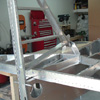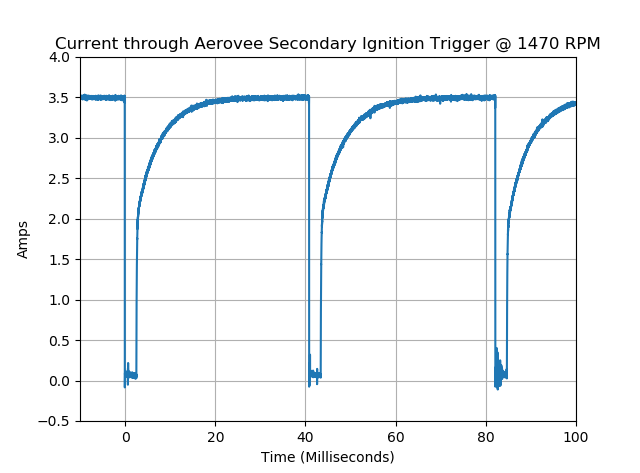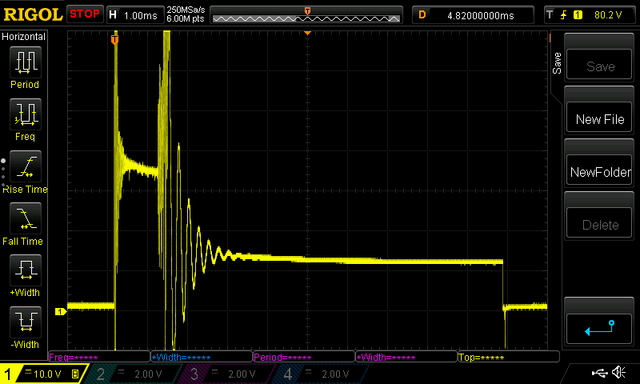


random user submitted photo
Problem with Secondary ignition...
48 posts
• Page 3 of 5 • 1, 2, 3, 4, 5
Re: Problem with Secondary ignition...
Ignition wires are new and routed correctly. All plugs new(less than 5 hrs time on them) and #2 lower plug replaced with brand new when problem arose. I guess next step is to undo my entire FWF wiring harness and individually inspect all wires pertaining to the secondary ignition. Still can't for the life of me see how only one cylinder is affected. George.
- sonex1020x
- Posts: 17
- Joined: Thu Apr 01, 2021 11:25 am
Re: Problem with Secondary ignition...
Bryan Cotton wrote:How are your coils grounded? Just through the firewall mount or do you have a dedicated ground? If through the firewall maybe that ground connection has degraded with age. You could run a dedicated ground to the coil mounts and see.
You can see my dedicated ground wires.
George what does your grounding look like?
Bryan Cotton
Poplar Grove, IL C77
Waiex 191 N191YX
Taildragger, Aerovee, acro ailerons
dual sticks with sport trainer controls
Prebuilt spars and machined angle kit
Year 2 flying and approaching 200 hours December 23
Poplar Grove, IL C77
Waiex 191 N191YX
Taildragger, Aerovee, acro ailerons
dual sticks with sport trainer controls
Prebuilt spars and machined angle kit
Year 2 flying and approaching 200 hours December 23
-

Bryan Cotton - Posts: 5489
- Joined: Mon Jul 01, 2013 9:54 pm
- Location: C77
Re: Problem with Secondary ignition...
Hi Bryan. Coils are grounded to firewall and to the neg. batt post. Triggers are grounded to a "forest of tabs" block with everything else. Still just perplexed as how only one cylinder can be affected.George.
- sonex1020x
- Posts: 17
- Joined: Thu Apr 01, 2021 11:25 am
Re: Problem with Secondary ignition...
I had a problem with one cylinder not firing on one plug after startup. I thought it was a bad coil. However, before changing the coil, I began checking the other cylinders with a spark tester and discovered I had a second weak spark on another plug. Turns out that when assembling the plug wires I had misinterpreted the instructions and not properly installed the plug wire end clips, (failed to fold center lead back over the outer portion of the wire to make contact with the clip). Considering you have changed the wires already, this is not likely the case. In my case, the only reason the engine was running fine (over 40 hrs) was because the spark was jumping the gap in the wire socket to the wire as evidenced by black residue in the coil socket.
Tnhelm
OneX 0137
Tnhelm
OneX 0137
- Tnhelm
- Posts: 63
- Joined: Sun Nov 17, 2013 11:46 pm
Re: Problem with Secondary ignition...
I will definitely check the new plug wires I assembled, but it seems odd it's still the #2 cylinder not firing. Will also swap the wires on the right hand coil and see if now #4 EGT falls off. George.
- sonex1020x
- Posts: 17
- Joined: Thu Apr 01, 2021 11:25 am
Re: Problem with Secondary ignition...
George
This is out there, but a post on another forum madame think of it. In high school we used to take a pencil and put a mark down a spark plug wire, and then watch our fellow classmates pull out their hair trying to figure out why it was misfiring. Not saying you have a pencil line, but is there any exterior contamination that could be causing a short? Run the engine in the dark and see if there is any arcing.
This is out there, but a post on another forum madame think of it. In high school we used to take a pencil and put a mark down a spark plug wire, and then watch our fellow classmates pull out their hair trying to figure out why it was misfiring. Not saying you have a pencil line, but is there any exterior contamination that could be causing a short? Run the engine in the dark and see if there is any arcing.
Bob Dz...
Sonex B, Tri-gear
(technically within walking distance of Sonex)
N624DZ (reserved)
Plans exist to eliminate confusion, not create it.
Sonex B, Tri-gear
(technically within walking distance of Sonex)
N624DZ (reserved)
Plans exist to eliminate confusion, not create it.
- BobDz
- Posts: 265
- Joined: Mon Oct 02, 2023 3:44 pm
Re: Problem with Secondary ignition...
Hi all. Update. After installing 2 new coils, new ignition wires, plugs, and verifying all that done correctly, no joy. She still runs just fine on the primary ignition, but very rough on just the secondary, with the #2 cylinder's EGT falling off. All the other 3 EGT's are normal. Sonex recommended testing the triggers by using a voltmeter, pos probe on the orange wire at the coil, neg probe on good ground. With trigger cap magnet aligned with the trigger, I should get batt voltage. rotated another 180 degrees, should get around 1.5 volts. This of course with the secondary ignition on. I tried this and got batt voltage no matter how the prop was positioned, clear through 360 degrees. Never saw a lower voltage reading. This was consistent with both trigger assemblies. I have no idea what the results of this test is telling me. Any ideas ? Clearly my coils,wire and plugs were fine and weren't the culprit . I hate to spend another $242 for triggers if they are not bad. George.
- sonex1020x
- Posts: 17
- Joined: Thu Apr 01, 2021 11:25 am
Re: Problem with Secondary ignition...
Like you, I'm somewhat skeptical that a trigger can cause one half of a coil to fail. I would assume you gap per the aerovee manual to 0.032" for the primary ignition. It might be interesting to try a closer gap on the #2 plug and see what happens. Also have you checked compression? As pressure gets lower there is less resistance for a spark to jump, which is why some airplanes have pressurized mags if they are going to altitude. Maybe the #4 cylinder is weak and the current is all going in that direction from the coil, but with the smaller gap on the primary plugs this has not manifested itself there yet. That would be an easy experiment to try if you had some old plugs laying around, which I bet we all do!
Edit: one way to rule out triggers would be to swap them.
Edit: one way to rule out triggers would be to swap them.
Bryan Cotton
Poplar Grove, IL C77
Waiex 191 N191YX
Taildragger, Aerovee, acro ailerons
dual sticks with sport trainer controls
Prebuilt spars and machined angle kit
Year 2 flying and approaching 200 hours December 23
Poplar Grove, IL C77
Waiex 191 N191YX
Taildragger, Aerovee, acro ailerons
dual sticks with sport trainer controls
Prebuilt spars and machined angle kit
Year 2 flying and approaching 200 hours December 23
-

Bryan Cotton - Posts: 5489
- Joined: Mon Jul 01, 2013 9:54 pm
- Location: C77
Re: Problem with Secondary ignition...
Hi George,
I've heard rumors that the new Sonex secondary ignition module shuts down after some period of inactivity to keep from burning up coils. Does anybody know if that is true?
Anyway, let me try to explain the way the secondary worked back in the day on my AeroVee. It might at least provide some food for thought. Since I owned an AeroVee Sonex LLC has changed coils and obsoleted the old trigger module. Things might be a little different now. But here's how mine worked.
While the secondary ignition switch is on, there is 12 volts on one side of the primary winding. The other side of the primary went to the ignition module. The ignition module side was basically GROUNDED while the trigger magnet was NOT aligned with the sensor in the trigger module. When the trigger magnet WAS aligned with the sensor in the trigger module the ignition module side was OPEN.
So, for most of the time the ignition module side of the coil was grounded and the coil was charging, then, when the magnet passed the (hall effect) sensor in the ignition module, the ignition side of the primary opened up. Much like a set of points opening up.
Here is a pic Chris Madsen posted a long time ago that illustrates whats going on. The pic shows the current passing through the primary of the coil. The current jumps to zero when the magnet passes the sensor. This causes a large induced voltage in the coil secondary winding and the plugs (should) fire.

Here is a pic of the voltage on the ignition module side of the coil primary when the ignition module opens the circuit.

If you compare the two pics, when the current in Chris's pic goes to zero you can see the large voltage spike on the voltage pic. That spike starts the spark event. Then there is a flat spot on the voltage pic. That's while current is actually "jumping" the plug gaps.
Next comes the ringing on the voltage pic. That when there is no longer enough voltage on the coil secondary to arc the plug so the current in the coil secondary suddenly stops. That sudden stoppage reflects back on the primary much like what happened on the secondary when the current in the primary suddenly stopped.
Anyway, what comes next, after the ringing, the ignition module side settles in at 12 V. At that point the circuit is still open and no current is flowing in the coil primary so all you see is the 12 V power on the other end of the primary winding. That continues until the magnet clears sensor. At the very end of the voltage trace you can see the magnet clear the sensor and the module side of the primary is again grounded and the process repeats.
For dual plug coils to fire both plugs at the same time there is only one secondary winding. So, the plugs are in series with the secondary winding. In theory the secondary winding is "sucking" current from one plug and "pushing" it to the other plug. Not always the case though. If the coil arcs internally or if there is enough inner-winding capacitance (or some such techno babble) there may be enough current/charge available to fire only one plug.
Enough of that. So what to do.
Assuming you have done whatever you deem appropriate to ensure that you can fiddle with the prop while the secondary ignition is on without the engine firing, I would start by seeing if you can fire the plugs by exercising the ignition module by hand. You can do that hooking a volt meter to the ignition module side of the coil primary and moving the prop so as to make the trigger magnet pass in front of the sensor. You should see 12 volts (after a healthy spike) while the magnet is passing the sensor and zero volts while the magnet is clear of the sensor. If that works, then you have a good idea that the ignition module and trigger magnet are OK. This assumes the new ignition module works the same as the old ignition module.
Wes
I've heard rumors that the new Sonex secondary ignition module shuts down after some period of inactivity to keep from burning up coils. Does anybody know if that is true?
Anyway, let me try to explain the way the secondary worked back in the day on my AeroVee. It might at least provide some food for thought. Since I owned an AeroVee Sonex LLC has changed coils and obsoleted the old trigger module. Things might be a little different now. But here's how mine worked.
While the secondary ignition switch is on, there is 12 volts on one side of the primary winding. The other side of the primary went to the ignition module. The ignition module side was basically GROUNDED while the trigger magnet was NOT aligned with the sensor in the trigger module. When the trigger magnet WAS aligned with the sensor in the trigger module the ignition module side was OPEN.
So, for most of the time the ignition module side of the coil was grounded and the coil was charging, then, when the magnet passed the (hall effect) sensor in the ignition module, the ignition side of the primary opened up. Much like a set of points opening up.
Here is a pic Chris Madsen posted a long time ago that illustrates whats going on. The pic shows the current passing through the primary of the coil. The current jumps to zero when the magnet passes the sensor. This causes a large induced voltage in the coil secondary winding and the plugs (should) fire.

Here is a pic of the voltage on the ignition module side of the coil primary when the ignition module opens the circuit.

If you compare the two pics, when the current in Chris's pic goes to zero you can see the large voltage spike on the voltage pic. That spike starts the spark event. Then there is a flat spot on the voltage pic. That's while current is actually "jumping" the plug gaps.
Next comes the ringing on the voltage pic. That when there is no longer enough voltage on the coil secondary to arc the plug so the current in the coil secondary suddenly stops. That sudden stoppage reflects back on the primary much like what happened on the secondary when the current in the primary suddenly stopped.
Anyway, what comes next, after the ringing, the ignition module side settles in at 12 V. At that point the circuit is still open and no current is flowing in the coil primary so all you see is the 12 V power on the other end of the primary winding. That continues until the magnet clears sensor. At the very end of the voltage trace you can see the magnet clear the sensor and the module side of the primary is again grounded and the process repeats.
For dual plug coils to fire both plugs at the same time there is only one secondary winding. So, the plugs are in series with the secondary winding. In theory the secondary winding is "sucking" current from one plug and "pushing" it to the other plug. Not always the case though. If the coil arcs internally or if there is enough inner-winding capacitance (or some such techno babble) there may be enough current/charge available to fire only one plug.
Enough of that. So what to do.
Assuming you have done whatever you deem appropriate to ensure that you can fiddle with the prop while the secondary ignition is on without the engine firing, I would start by seeing if you can fire the plugs by exercising the ignition module by hand. You can do that hooking a volt meter to the ignition module side of the coil primary and moving the prop so as to make the trigger magnet pass in front of the sensor. You should see 12 volts (after a healthy spike) while the magnet is passing the sensor and zero volts while the magnet is clear of the sensor. If that works, then you have a good idea that the ignition module and trigger magnet are OK. This assumes the new ignition module works the same as the old ignition module.
Wes
Wes Ragle
Onex #89
Conventional Gear
Long Tips
Hummel 2400 w/Zenith Carb
Prince P Tip 54x50
First Flight 06/23/2020
42.8 Hrs. as of 10/30/21
Onex #89
Conventional Gear
Long Tips
Hummel 2400 w/Zenith Carb
Prince P Tip 54x50
First Flight 06/23/2020
42.8 Hrs. as of 10/30/21
- WesRagle
- Posts: 899
- Joined: Fri Jan 05, 2018 12:35 pm
- Location: Weatherford, Tx
Re: Problem with Secondary ignition...
Hi Wes. That's alot of information,most of which goes over my head... Just a re-cap of what I've tested and the results, before I just go ahead and order new triggers for $242 ! Removed all 4 bottom pugs, and grounded them, one at a time, to observe for spark. Secondary ignition on, rotated prop and saw spark on #1 and #3 cyls. No spark observed on #2 or #4 . Remember, both coils new. Tested triggers per Sonex by aligning trigger magnet with module and measuring voltage (again, secondary on ) at orange wire/coil junction. I got batt voltage. Rotated prop to 180 deg and looked for about 1.5 volts per Sonex. but still got batt voltage. I got the same reading no matter where the prop was positioned. Never saw a lower voltage. This was consistent with both trigger's orange wires. Just looking to know if this test proves anything. Thx. George.
- sonex1020x
- Posts: 17
- Joined: Thu Apr 01, 2021 11:25 am
48 posts
• Page 3 of 5 • 1, 2, 3, 4, 5
Who is online
Users browsing this forum: No registered users and 17 guests







